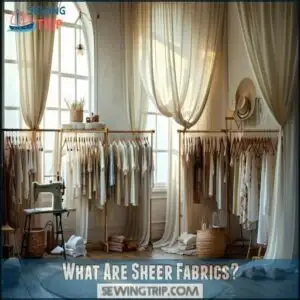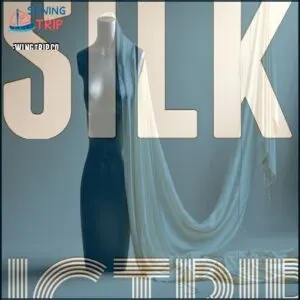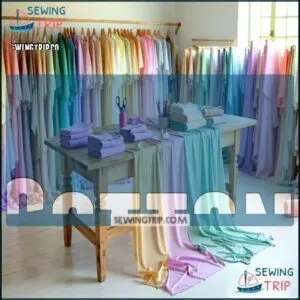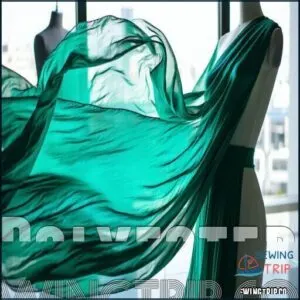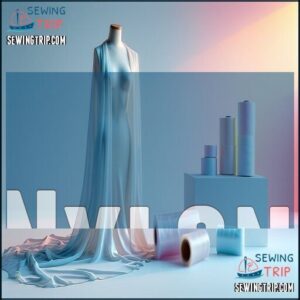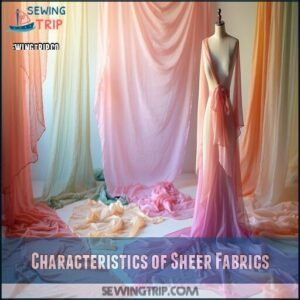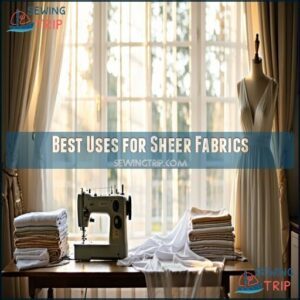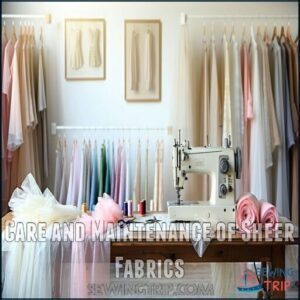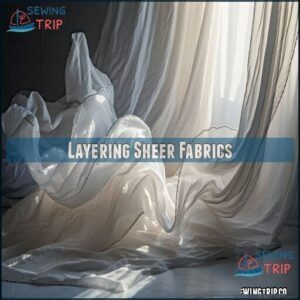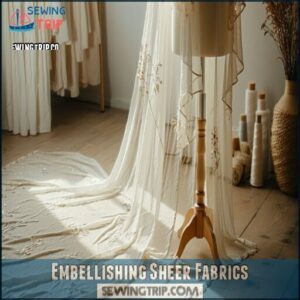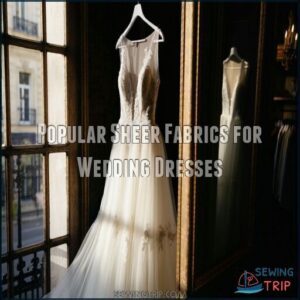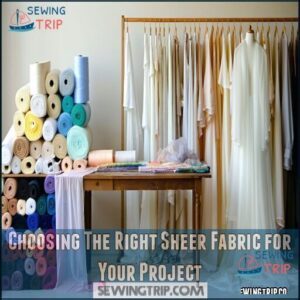This site is supported by our readers. We may earn a commission, at no cost to you, if you purchase through links.
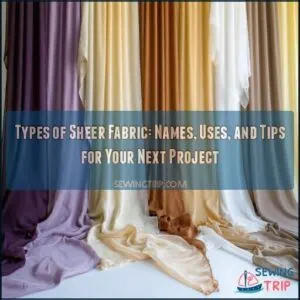 In the context of types of sheer fabric, you’ve got plenty of choices, each adding a different kind of magic to your project.
In the context of types of sheer fabric, you’ve got plenty of choices, each adding a different kind of magic to your project.
Chiffon is ethereal and flowing, perfect for gowns or scarves.
Organza holds its shape with a crisp texture, making it great for overlays or decorative details.
Want something softer? Try tulle—ideal for dreamy wedding veils or ballet skirts.
If you’re thinking luxurious, silk georgette has a delicate drape with just a hint of shimmer.
Polyester and nylon blends offer durability without losing that airy quality.
Each fabric tells its own story—your job is picking the perfect chapter!
Table Of Contents
- What Are Sheer Fabrics?
- Natural Fiber Sheer Fabrics
- Synthetic Fiber Sheer Fabrics
- Characteristics of Sheer Fabrics
- Best Uses for Sheer Fabrics
- Care and Maintenance of Sheer Fabrics
- Layering Sheer Fabrics
- Embellishing Sheer Fabrics
- Popular Sheer Fabrics for Wedding Dresses
- Choosing The Right Sheer Fabric for Your Project
- Frequently Asked Questions (FAQs)
- Conclusion
What Are Sheer Fabrics?
Sheer fabrics are lightweight, airy materials known for their transparent or semi-transparent qualities.
With delicate weave patterns and low thread counts, they add elegance to clothing and décor. Fabric types like silk, cotton, and polyester each offer unique textures and uses.
These versatile materials shine in warm-weather wear, curtains, and accessories. Precision matters when working with sheer fabrics—French seams or invisible hems keep stitches neat.
Enhance their charm with embellishments, like embroidery, to elevate their natural transparency and create timeless, stylish projects. To achieve professional results, understanding sewing techniques is essential for handling these delicate materials, which requires a good understanding of sewing techniques.
Natural Fiber Sheer Fabrics
Natural fiber sheer fabrics bring a lightweight, breathable option to your projects with the timeless elegance of materials like silk and cotton.
They offer both versatility and natural beauty, making them ideal for anything from delicate garments to stylish home decor.
Silk
Silk is the queen of luxury in the context of sheer fabrics, offering a perfect blend of elegance and versatility.
This natural fiber, renowned for its plush feel and radiant silk sheen, has captivated generations. Sheer silk options like silk chiffon, silk organza, and silk georgette add an airy charm to garments, making them ideal for flowing gowns, bridal veils, or even ethereal layered designs.
Silk production and skilled silk weaving create its lightweight yet durable texture, while silk dyeing techniques infuse vibrant hues that highlight its translucent beauty. Fabrics like silk tulle fabric and sheer silk satin exude grace, perfect for formal wear.
Handling silk demands patience—it’s slippery by nature. Use sharp needles, stable surfaces, and a gentle touch during silk finishing to maintain its delicate allure.
Cotton
Looking for versatility in sheer fabric? Cotton sheer fabrics might just win you over. Lightweight and breathable, they’re perfect for summer clothes or sheer fabric for curtains.
The sheer cotton weave fabric, like voile or lawn, varies in transparency based on thread count and cotton weaving techniques. Its fabric dyeing easily results in vivid colors and charming designs.
- Pick cotton blends for added strength.
- Use straight stitches for smooth seams.
- Press seams gently with low heat.
- Experiment with embroidery for flare.
- Leverage cotton finishing techniques for durability.
Synthetic Fiber Sheer Fabrics
Synthetic fiber sheer fabrics, like polyester and nylon, offer durability and a lightweight feel that’s perfect for both practical and decorative uses.
They’re easy to care for and come in various textures and transparencies, making them a versatile option for many projects.
Polyester
For versatility and affordability, sheer polyester fabric is unmatched.
Known for its durability and wrinkle resistance, it’s perfect for synthetic sheer materials that hold shape beautifully, whether it’s flowing dresses, polyester chiffon, or vibrant scarves.
The polyester drape adds elegance to clothing, while its excellent dyeing capabilities bring bold colors to life.
Beyond fashion, it suits home décor, like curtains, thanks to low maintenance and polyester care.
Plus, polyester blends deliver softness without sacrificing strength, making it a smart choice among sheer fabric types.
Nylon
In the context of reliable, lightweight solutions in sheer fabrics, nylon truly shines.
Known for its strength and flexibility, nylon is perfect for projects requiring both durability and elegance.
Whether you’re crafting intimate sportswear, ethereal nylon chiffon, or even sturdy nylon netting for outdoor uses, this fabric offers unmatched versatility.
With its ability to hold vibrant dyes, sheer nylon creation stands out in color-rich projects.
Wondering, is nylon sheer enough for delicate designs?
Absolutely—it’s a translucent wonder.
Fabric blends with nylon also create semi-sheer materials that balance softness and toughness perfectly.
For lasting results, focus on nylon care: use gentle washes and finish seams carefully to avoid fraying.
Nylon makes bold fabric choices look effortless and wearable.
Characteristics of Sheer Fabrics
Sheer fabrics stand out for their light, airy feel and delicate appearance, making them both functional and stylish.
Their key traits—transparency, texture, and color—add versatility to your projects, offering countless creative possibilities.
Transparency
Sheer fabrics stand out with their varying transparency levels, letting you play with light transmission and design depth.
Varying transparency in sheer fabrics lets you dance with light, layering elegance and mystery into every design.
Transparency levels depend on the denier rating, with lower ratings making fabrics more see-through. Want a glowy, airy look? Opt for translucent fabrics to scatter light beautifully.
For added creativity, try:
- Use transparent fabrics like organza for dramatic layers.
- Combine semitransparent fabrics like tulle with opaque fabrics for texture.
- Balance fabric opacity by adding pleats or gathers.
- Choose visible thickness for durability and structure.
Color
Color breathes life into sheer fabrics, offering endless possibilities to match your mood or project goals. From soft pastels to vibrant hues, sheer fabric colors cater to every style and purpose.
Advances in Dye Effects make nearly any shade achievable, opening the door to limitless Hue Options. Whether you’re layering transparent fabric for shadowed depth or using bright, Saturation Levels for a bold statement, color transforms semi-transparent textures into artistic expressions.
When choosing a shade, explore Color Theory for inspiration. Think Tint Shades like soothing blues for calmness, fiery reds for energy, or timeless neutrals for versatility.
Lighter colors can fade, so opt for high-quality dyes to guarantee longevity. And don’t forget how sheer fabric types affect the way colors are perceived—organza might sparkle, while soft cotton gives a muted glow. Understanding fabric weave types is also vital for achieving the desired color effect.
- Layer complementary hues for harmony.
- Add contrasts for impact.
- Match trends for modern vibes.
- Balance saturation for depth.
Texture
Not all fabrics let their texture speak like sheer ones do.
The way a sheer fabric feels in your hand—the fabric hand—says a lot about its personality.
It could be the buttery surface smoothness of silk chiffon or the crisp snap of organza.
Texture gives a transparent fabric its movement and charm.
The fabric weave, thread count, and even material blend define whether it feels soft and flowy or stiff and structured.
Voile, with its airy fabric feel, drifts elegantly, while stiffer materials like tulle bring a playful texture that holds its shape.
Look closer—many delicate see-through fabrics are prone to fraying.
To keep them happy, techniques like French seams or pin hems work wonders.
And don’t forget how a semi-transparent texture fabric, in layers, can open up your designs to limitless possibilities, blending softness and strength effortlessly.
Best Uses for Sheer Fabrics
You can use sheer fabrics to create lightweight, breathable clothing that feels elegant and airy.
They’re also perfect for adding a soft, decorative touch to home decor like curtains or table overlays.
Clothing
In the context of clothing, sheer fabric creates a perfect blend of elegance and daring. From flowing sheer dresses to playful sheer blouses, these fabrics help you craft stunning outfits that are as light as air.
Sheer skirts, sheer overlays, and even sheer lingerie can add texture, movement, and a touch of mystery to your wardrobe. Transparent fabric is all about subtlety—showing just enough without revealing too much.
To learn more about working with sheer fabrics, understanding sheer fabric types is essential for selecting the right material for your project.
To make the most of sheer fabric in your sewing projects, pay attention to these tips:
- Layer wisely: Use sheer overlays to create depth and dimension without overwhelming your design.
- Finish seams carefully: Techniques like French seams make sheer blouses and other garments look polished.
- Add support: Use interfacing for stability on tricky sections to keep fabric cuts crisp.
- Keep tools sharp: Precision scissors are a must for clean cuts and smooth edges.
Home Decor
When your space feels heavy, let sheer curtains add lightness and charm.
Drapery panels in voile fabric or organza fabric soften lighting while preserving privacy. Room dividers crafted from tulle or chiffon fabric define spaces elegantly without closing them off.
Want decorative accents? Use georgette or lace table runners for a touch of refinement.
Even canopy highlights or lighting diffusers benefit from sheer fabric’s transparency. Remember, low heat protects these delicate materials—your home deserves effortless beauty with transparent fabrics creating a timeless, airy vibe!
Care and Maintenance of Sheer Fabrics
Taking care of sheer fabrics requires a gentle touch and a bit of patience to keep them looking their best.
From cutting and sewing to pressing seams and hemming, each step plays a role in preserving their delicate beauty.
Cutting and Sewing
Working with lightweight, see-through materials like chiffon or voile feels like taming a spirited breeze—it’s delicate but rewarding.
Successful projects start with thoughtful pattern making, favoring simple designs over overly detailed ones. For specialized cutting tools, consider exploring sheer fabric scissor options.
When cutting sheer fabric, place it between tissue paper to avoid shifting and jagged edges.
Sewing sheer fabric into clothes demands the right tools and patience. Use a fine needle, like size 9 or 11, paired with lightweight thread for smooth results.
To prevent fraying, finish seams with techniques like these:
- French seams for clean, elegant edges.
- Rolled hems to create polished, lightweight finishes.
- Fabric weights or pins to hold tricky fabrics in place.
- Rotary cutters for precise cuts that avoid fraying.
Careful preparation makes sewing sheer fabric effortless!
Pressing Seams
Pressing sheer fabric seams doesn’t have to feel like a tightrope walk. With the right pressing tools and gentle care, you’ll keep that delicate fabric texture flawless.
Always use a pressing cloth to shield fabrics like silk or polyester from heat. Set your iron temperature carefully—too hot, and you’ll risk warping the fabric stretch or leaving shiny marks. Steam can work wonders on creases, but don’t let moisture wreak havoc with distortion.
Here’s a quick guide:
Using a steam iron system can be particularly helpful in managing wrinkles. Remember, pressing sheer fabric is like taming a skittish cat—patience wins. Always test on scraps first!
Hemming
Hemming sheer fabric is an art that transforms fraying edges into polished perfection.
To achieve precision, use hemming tools and master essential sewing techniques suited to transparent fabrics.
Here are your go-to methods:
- Folded Hems: Ideal for hemming fabric with natural fibers, adding a clean, durable finish.
- Blind Hem: Subtle edge finishing for flowing garments like dresses or curtains.
- Hand-Sewn Hemming: Perfect for intricate textures, offering control and professional quality.
Always test on scraps to preserve fabric texture and elegance!
Layering Sheer Fabrics
Layering sheer fabric is like creating art with shadow and light. By combining different sheer fabric types and names, you’ll achieve stunning transparent effects and dynamic textures.
Pair lightweight options like sheer chiffon with silk voile for graceful drape or mix airy organza with cotton muslin for structured layers.
Prewash fabric overlays to prevent surprises and use gentle pressing to maintain that semi-transparent texture fabric.
With thoughtful fabric stacking, mixing colors, and balancing weight, your designs can transform into layered textures full of elegance and depth.
To guarantee professional results, mastering sewing techniques is vital for working with sheer fabrics.
Embellishing Sheer Fabrics
Embellishing sheer fabrics lets you get creative while adding unique touches like embroidery or beading.
These lightweight, delicate materials require careful attention, but the results can bring elegance and personality to any project.
Embroidery
When you’re adding embroidery to see-through fabric like chiffon or tulle, a few smart techniques guarantee success.
Start with hooping methods—use a lightweight embroidery hoop to avoid overstretching. Choose fine thread choices that complement the fabric’s airiness and add delicate details.
Use stabilizers to prevent puckering, especially with sheer fabric for embroidery. Thoughtful design placement matters; openwork or floral patterns keep things light yet stunning.
With patience, your sheer appliqué creations will turn any project into a delicate masterpiece. To achieve professional results, understanding embroidery hoops is essential for maintaining even tension.
Beading
In the case of sheer fabrics like chiffon, georgette, or lace, beading can instantly transform them into breathtaking statement pieces. Beading adds shimmer and elegance, giving lightweight, transparent fabric a sophisticated edge without sacrificing its airy feel.
Start by selecting bead types that complement your material. Seed beads are perfect for subtle accents, while larger crystals or sequins create dramatic focal points. Bead colors play a big role too—soft pastels bring grace, while vibrant shades add bold flair.
Plan bead patterns carefully to balance beauty and functionality. Flowing lines or symmetrical designs work well, but avoid overloading areas to maintain comfort and movement. Use proper beading tools, such as a fine needle and strong thread, to protect delicate fabrics.
Beading sheer fabrics requires patience, but the payoff is dazzling. A touch of sparkle can elevate your project from simple to showstopping.
Popular Sheer Fabrics for Wedding Dresses
Sheer fabrics like silk organza, chiffon fabric, and tulle fabric bring magic to wedding gowns.
Silk organza offers structure and crisp elegance, perfect for ball gowns or A-line silhouettes, while its strength supports embellishments like bridal lace.
For romantic draping, chiffon fabric creates soft, flowing designs ideal for beach or outdoor weddings.
Tulle fabric, airy and voluminous, is a classic for wedding veils and layered sheer overlays.
Each fabric promises a unique balance of texture, charm, and versatility for your dream bridal look!
When working with these delicate materials, understanding breathable fabric properties is essential for achieving the desired effect.
Choosing The Right Sheer Fabric for Your Project
Choosing the right sheer fabric for your project is all about aligning material with purpose.
With so many types of sheer fabric available, narrow your options by considering these factors: Consider project-specific fabric needs for superior results.
- Fabric Selection: Does your project require a structured transparent fabric like organza or a soft, breathable fabric like chiffon for a gentle drape? Match the material with your goals.
- Material Comparison: Natural fibers like silk offer elegance but higher costs, while synthetic options like polyester provide durability at a budget-friendly price.
- Texture Analysis: For a delicate, lightweight fabric, opt for voile or tulle. For stronger, more defined shapes, choose organdy.
- Color Matching: Think about the tone and opacity of the sheer fabric. Bright whites enhance freshness, while creams evoke warmth.
Plan carefully, experiment with swatches, and trust your instincts for the perfect balance of style and functionality!
Frequently Asked Questions (FAQs)
Are there different types of sheer fabrics?
There are many types of sheer fabrics, like silk for elegance, polyester for durability, and organza for structure.
Each varies in texture and transparency, perfect for fashion, curtains, or adding character to any design, with silky elegance being a key aspect.
What are the different types of sheer materials?
Imagine sunlight filtering through clouds—that’s sheer fabric for you.
Explore silk for softness, cotton for versatility, polyester for durability, organza for elegance, nylon for strength, and rayon for a balanced, airy charm, which offers a unique elegance.
What are sheer fabrics made of?
You’ll find sheer fabrics made from silk, cotton, polyester, rayon, or nylon.
Each material offers unique qualities, from silk’s softness to polyester’s durability, letting you choose the perfect combination of style, texture, and function.
What is the best sheer fabric?
The best sheer fabric depends on what you need!
Silk feels luxurious and elegant, while polyester offers durability and easy care.
Want lightweight strength? Go for nylon. Each sheer fabric shines in its unique way!
What are the characteristics of a sheer fabric?
Pulling back the curtain, sheer fabrics blend lightness and elegance.
They’re semi-transparent, letting light and shapes peek through subtly.
Made from silk, cotton, or synthetics, their airy nature enhances clothing, decor, and artistic expressions beautifully.
What are the different types of sheer silk?
Silk sheer fabrics include chiffon, georgette, organza, and tulle.
Chiffon feels light and floaty, perfect for elegance.
Georgette adds texture and durability.
Organza provides structure, while tulle works great for layering and volume-enhancing designs.
What is sheer fabric?
Sheer fabric, ironically enough, hides little yet speaks volumes.
It’s a lightweight, semi-transparent material that adds elegance and mystery.
Made from silk, cotton, or synthetics, it allows light to pass through effortlessly.
What to do with a sheer fabric?
Use sheer fabric to make flowing curtains, delicate scarves, or elegant overlays for clothing.
It’s perfect for softening harsh lighting or creating romantic decor, adding a touch of sophistication without overwhelming the design.
How to make sheer fabric opaque?
Think of sheer fabric like frosted glass—beautiful but see-through.
To make it opaque, layer it with a thicker fabric, dye it darker, or add a backing material like lining or interfacing.
What is the usage of sheer fabric?
You can transform spaces or outfits with sheer fabric, whether it’s adding soft light to a room as curtains.
Crafting elegant dresses, or layering for a breezy, delicate touch in fashion and decor.
Conclusion
Choosing the right sheer fabric is like finding the perfect spice for a recipe—it transforms your project.
With so many types of sheer fabric like chiffon, organza, or tulle, you’ve got endless creative possibilities.
Whether you’re crafting elegant clothing, dreamy home decor, or intricate wedding gowns, sheer fabrics bring a unique charm.
Remember to keep in mind texture, durability, and care needs when making your selection.
Jump into experimentation and let your creativity shine with these versatile materials!
- https://fabricwholesaledirect.com/blogs/sewing-diy-tutorials/5-types-of-sheer-fabric?srsltid=AfmBOopqC4sx1B-RB0s6yirwJTZf27EhITgwF_JErUvHlue_8X88CeYP
- http://www.fousttextiles.com/shop/Search-by-Material/BridalSpecial-Occasion/Sheer-Fabrics-Chiffon-Tulle-Nylon-Net-Organza.htm
- https://northshorecrafts.com/what-is-the-sheer-fabric-called/?srsltid=AfmBOorYQpEZzCdvNq4lQLuJn5dOIjmiQ26rCwYL-HPb2XW1l8TSmtej
- https://fashinza.com/fabric/guide/different-types-of-fabric-sheer-price-and-where-to-buy-them-in-bulk/
- https://bestfabricstore.com/sheer-fabric.html?srsltid=AfmBOopf8aGPeNczhwOGgIRcxCYdf6bBNNQ6VBDCz5akcfRM4txuSyIB

